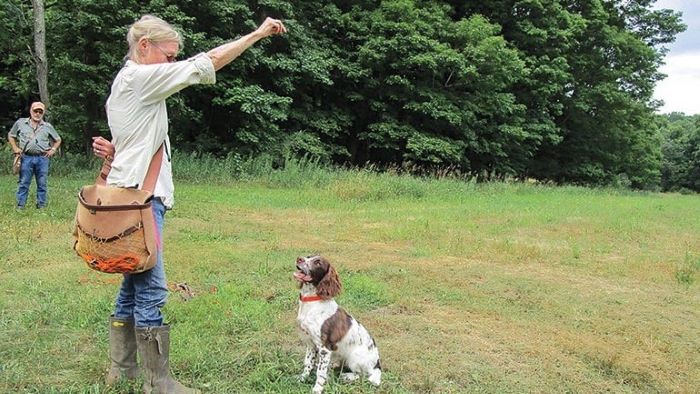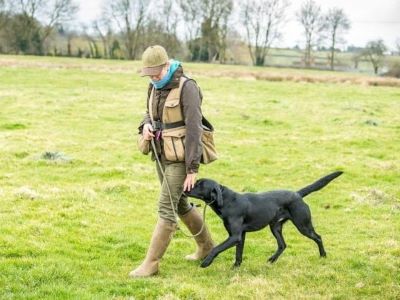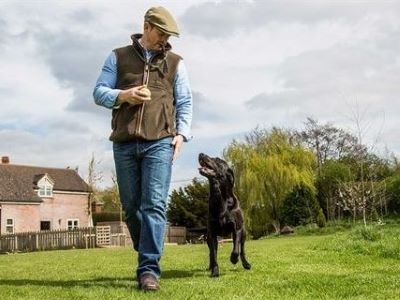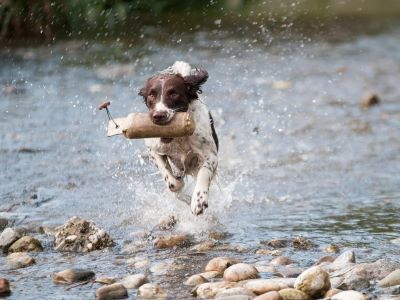Being with a gun dog is a special joy. It is great to be with them and share the enthusiasm of playing and living with them, but “How to train a gun dog?”
In this blog, we are going to understand different ways of training your gun dog. All the time spent in training with your dog will be memorable ( Trust us!) and without further ado let’s begin our exploration…

How to Train a Gun Dog?
Different dog breeds have various natural hunting abilities. Choosing a gun dog breed like Labrador, Retriever, Pointer, or Spaniel ensures that your dog already possesses the instincts needed for training.
Early training helps establish a strong foundation for your gun dog. Puppies are like sponges, eager to learn and please. The socialization period for puppies is between 3 and 14 weeks, making it an ideal time to start training. Begin basic training as soon as you bring your puppy home.
Basic obedience commands form the groundwork for more advanced gun dog training[1]. They improve communication between you and your dog. Consistency is crucial. Dogs respond the best to routine and repetition.
- Sit: Teach your dog to sit on command, a basic control cue.
- Stay: Train your dog to remain in one place until given a release command.
- Come: Establish a reliable recall command to ensure your dog returns quickly.
- Heel: Teach your dog to walk calmly beside you without pulling on the leash.
Use positive reinforcement such as treats and praise to reward the correct behaviour. Keep training sessions short and enjoyable to maintain your dog’s interest.

When starting training, having the proper equipment like the best gun dog slip leads UK retailers offer can help establish control and reinforce commands.
Building Foundation Skills
Retrieving is a very important skill for a gun dog. Teach your dog to fetch toys. Start with soft, light toys and throw them a short distance. Reward your dog with treats and praise when they bring the toy back. Slowly use heavier toys and throw them further away.
Get your dog comfortable with loud gunfire noises. Start with quiet popping sounds from far away while playing with your dog or giving treats. Slowly make the noises louder and closer. This will stop them from becoming scared of gunshots.
Take your dog to new places often. Go for walks in new neighbourhoods and parks. Meet new people and dogs. Visit pet stores together. This will help them be calm and well-behaved in different situations as an adult.
Training for Specific Tasks
Start by having your dog fetch toys over short distances. Slowly increase the distance and challenges. Use praise and treats to motivate them.
Gradually expose your dog to gunfire sounds while playing. Start soft and far away. Reward calm behaviour with treats. Slowly increase the volume and get closer. If your dog points, reward them for freezing at a scent. If they flush birds, practice that skill and follow with retrieves.
Use hand signals and whistle sounds for commands like sit and stay. Be consistent with commands. Slowly add distractions to simulate hunting conditions. Practice until your dog responds promptly in the field.

Advanced Training
Hide toys while your dog watches. Use commands to guide them to the hidden toy. Start close and easy, then go farther and more difficult spots. Practice in new places too.
Slowly get your dog comfortable in the water by starting shallow and using praise. Gradually go deeper. Add swimming, then do retrieves in water, first close to shore, then farther out. Consider waves, currents, and terrain.
First, have your dog watch you throw one toy, then get it. Gradually throw multiple toys in different spots. Use commands like “sit and stay” and then “fetch left toy”
Start easy then make it harder with more toys, distance, and different terrain. This prepares them to remember and retrieve multiple fallen birds.
The key is to start easy and use lots of encouragement and praise. Slowly make the exercises more challenging to build skills for real hunting situations. Match training to what your dog will face in the field.
Fine-Tuning
Use “sit” and “stay” so your dog learns to wait calmly for commands, even when excited. Slowly add distractions like decoys or noises. Praise staying steady until sent to retrieve.
Set up hunting situations for practice. Use different terrain, obstacles, scents, and fake birds. Start basic, then make it increasingly realistic and challenging to hone skills.
Meet up with well-trained dogs for group lessons. Practice basics like sitting, staying, and fetching. Dogs will learn from each other. Slowly increase distractions to make dogs work together and stay focused.

The key is to start easy, reward good behaviour, and slowly add realistic challenges. This prepares your dog to listen and perform reliably when real hunting with all its excitement and unpredictability.
Consistency and Positive Reinforcement
Dogs learn best with short, frequent training sessions instead of long, sporadic ones. Keep each session focused on one or two things. End on a positive note, even for small successes.
Always reward the same behaviours in the same way. Use the same commands. This avoids confusing your dog. Routine builds habit.
Frequent short, focused, reward-based sessions are most effective. Keep things positive and consistent. This approach trains an eager, well-behaved gun dog. Positive reinforcement encourages a positive association with training.
- Treats: Use high-value treats to reward correct behaviour immediately. Associate treats with specific commands or successful actions.
- Praise: Verbal praise in a happy, encouraging tone reinforces positive behaviour. Dogs respond well to the sound of their owner’s voice.
- Tip: Be timely with your rewards. The closer the reward is to the desired behaviour, the more effective it is in reinforcing that behaviour. Be consistent in your use of rewards to avoid confusion.
Combine play as a reward, especially if your dog is highly motivated by toys. Short play sessions can be effective in reinforcing good behaviour. Give treats, say “Good dog!”, or throw a ball immediately after the behaviour you want.
FAQs
What Is the Easiest Gun Dog to Train?
Curly Coat Retriever. They are great all-rounder dogs that can be trained to serve in nearly any role, including hunting, fieldwork, and retrieving. Curly Coated Retrievers have equally balanced size and structure which makes them very easy to train.
How to Train a Gun Dog?
Use mornings for training. Start by giving your dog a training dummy whenever they greet you in the morning. Then, take it back off them before they drop it and give them plenty of attention. You can also start leaving dummies around the house for your dog to bring to you in the morning or whenever you return home.
How Do I Train My Dog to Ignore Other Dogs?
Get their attention by calling their name. Do this randomly throughout the day. Avoid places with many dogs. Distract them when meeting other dogs. Practice is key. Give play opportunities. Use a long leash and avoid pulling on it.
How Not to Train Your Dog?
Cue nagging. One of the biggest problems is cue nagging. Poisoning of cues. Poisoning of cues is another trap that many first-time trainers fall into. Failing to practice in between classes. Useless repetition. Working when you’re frustrated.
Should I Train My Dog Myself?
Pro: DIY dog training can be a great way to establish a healthy relationship between you and your dog. It can also be more cost-effective than hiring a professional. Con: DIY dog training takes a lot of time, patience, and knowledge. Some individuals may not be up for the commitment or have the expertise.
Conclusion
In conclusion “How to train a gun dog?” We started with basic: sit, stay, mark, retrieve! Now it’s you, your dog and all the great fun in the world.
With the right training, your gun dog controls those impulses until given the green light. What skill! Here’s to many seasons of friendship, teamwork and adventures together!
In conclusion, we've covered the whole process of how to train a gun dog. But what is gun dog training ultimately for? It's to instill skills for hunting and fieldwork through progressive training tailored to the dog's breed and natural instincts.
Reference:
- American Kennel Club. (n.d.). Basic Dog Training: Obedience Commands & Dog Training 101 | AKC



